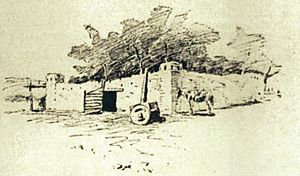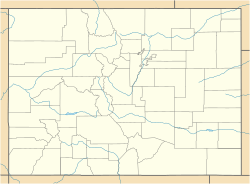El Pueblo (Pueblo, Colorado) facts for kids
Quick facts for kids
El Pueblo
|
|
|---|---|
|
Trading post
|
|
| Nickname(s):
Fort Pueblo, Fort Nepesta, Fort Fisher, Fort Juana, Fort Spaulding, Robert Fisher's Fort, Pueblo Almagre
|
|
| Country | United States |
| State | Colorado |
| County | Pueblo |
| Nearest town | Pueblo |
El Pueblo, also known as Fort Pueblo, was an important trading post and fort. It was located near the city of Pueblo in Pueblo County, Colorado. The fort was open from 1842 to 1854. People traded goods, animals, and farm products there. In 1854, the fort was attacked. Many people were killed, and others were captured. Today, a rebuilt version of the fort stands at the El Pueblo History Museum. It is on the same spot where the original fort once stood.
Contents
Building the Fort
This independent trading post was started in 1842. It was built by traders, trappers, and hunters. These people came from different backgrounds. Some were Mexican, French, European, or Native American. The idea for the fort came from George Simpson. He was a trader at Bent's Old Fort. Other people who likely helped build it include Mathew Kinkead, Joseph Mantz, Francisco Conn, and Robert Fisher. Joseph Doyle and Alexander Barclay also played a part. Teresita Sandoval was very important in running the fort every day.
When John C. Fremont visited in 1843, he noted that most of the men were mountain men. The women living there were mostly from Taos.
Where Was El Pueblo?
The fort was built just west of where Fountain Creek flows into the Arkansas River. At that time, the Arkansas River was the border. It separated Mexico from the United States. Two important trading paths were nearby. These were the Cherokee Trail and the Trapper's Trail. The Trapper's Trail was also called the Taos Trail. These routes helped people travel and trade goods.

Life Inside the Fort
El Pueblo was about 200 feet long and 200 feet wide. It had an entrance on its east side. There were strong towers, called bastions, at each corner. The buildings had flat roofs. These roofs were held up by large wooden beams. The fort was made of adobe, which is a type of mud brick. This made it strong and safe. It protected people from "Indians and thieving whites."
The fort likely had a gate and a central courtyard. The outside walls probably had no windows. Rooms were entered from the central plaza. A visitor named Francis Parkman said it was "nothing more than a large square enclosure." He also said its mud walls were "miserably cracked and dilapidated." Up to 100 to 150 people lived at El Pueblo. Each trader and their family had several rooms. These rooms were used for trading, living, cooking, storing goods, and blacksmith work.
Trading at the Fort
Goods were traded in the central plaza. People living at the fort grew crops and raised animals. These were traded along with other items. Buffalo hides were a popular item to trade. This was because the demand for beaver fur had gone down. Traders exchanged goods with Native American tribes. They traded for hides, animal skins, livestock, and plants. They also traded for liquor.
Archaeologists have found pieces of Native American pottery at the fort site. This shows that trade happened there. Other useful items were also found. Customers at the fort included traders from Taos. American trappers also came to trade. Famous visitors included James Beckwourth, Richens Lacey Wootton, and Kit Carson.
The Fort's Decline
Business at El Pueblo started to slow down in 1848. This was when the Mexican–American War began. Some traders left the fort to join the California Gold Rush in 1849. Around 1850, the demand for buffalo fur and robes also dropped. More and more new settlers were moving through Native American lands. The United States did not keep its promises in treaties. This caused problems and fighting in the area. By 1854, there was a terrible attack at the fort.
The Attack of 1854
The attack on Fort Pueblo happened between December 23 and December 25, 1854. This is according to people who traded at the fort, like George Simpson. A group of Utes and Jicarilla Apaches led the attack. Their leader was Tierra Blanca, a Ute chief. During the attack, many men were killed. Two children and one woman were also captured. Much of the fort's building was taken apart during the fighting.
What Happened Next?
After the attack, the trading post was left empty. But it became important again from 1858 to 1859. This was during the Pike's Peak Gold Rush of 1859. In 1891, parts of the old adobe walls could still be seen. They were near Union Avenue and the tracks of the Atchison, Topeka and Santa Fe Railway.
The river's path had changed a lot since the 1800s. So, the exact spot of the fort was lost. But in 1991, the University of Southern Colorado found it. They were doing an archaeological dig. The Farris Hotel had been built over the site. The fort was found underneath the hotel during the digging. Today, a smaller version of the fort has been rebuilt. It is at the El Pueblo History Museum. You can also see the archaeological site of the old fort there. The fort site was added to the National Register of Historic Places in 1996.


